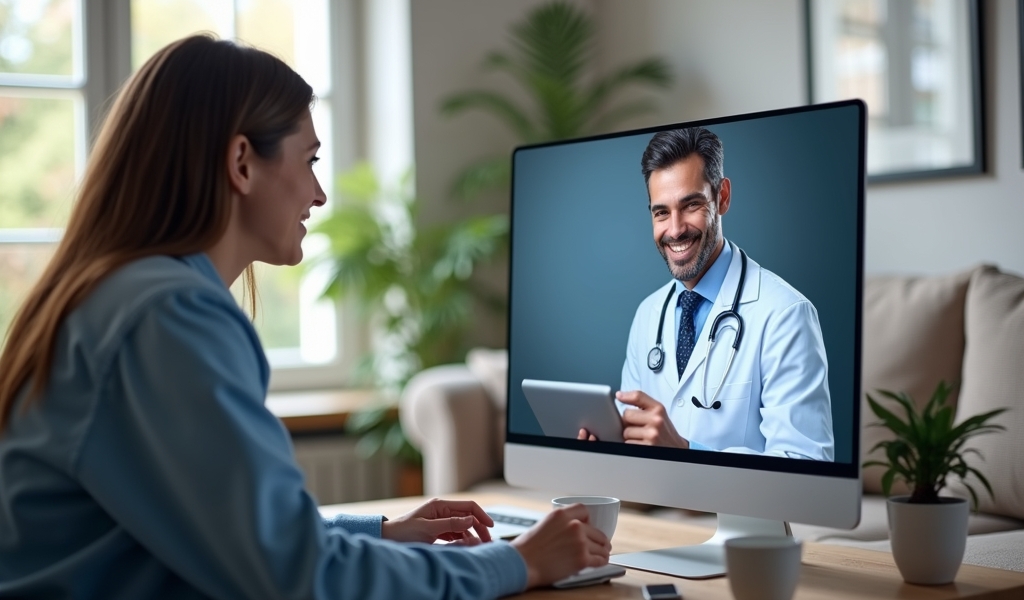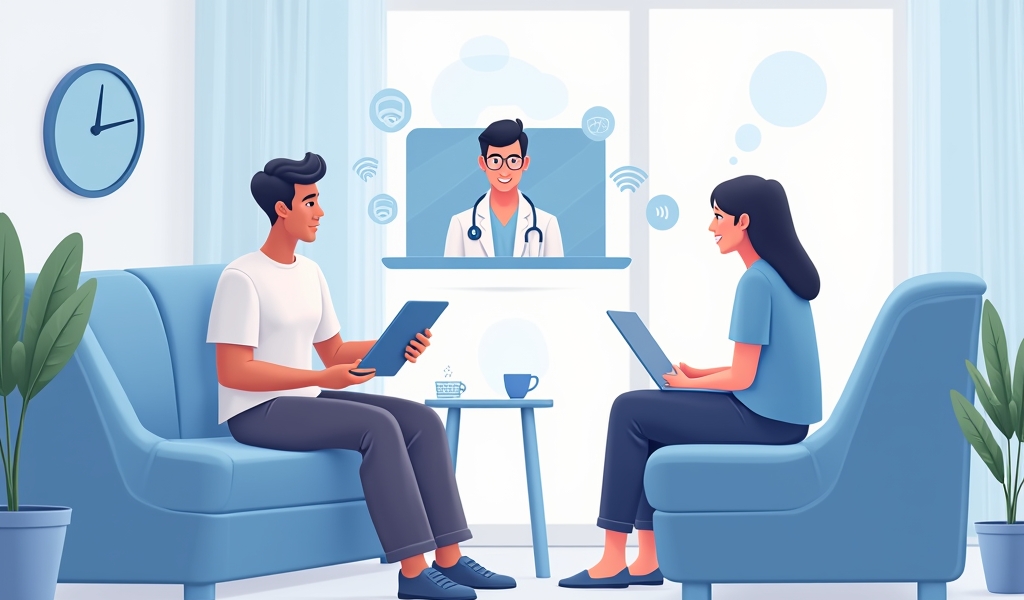Overview
Telehealth doctor visits offer five key benefits: unmatched convenience saving an average of 100 minutes per appointment, expanded healthcare access for rural and mobility-challenged patients, reduced infection risk, cost-effectiveness with 30-40% lower fees than in-person visits, and improved continuity of care for chronic conditions. This digital transformation in healthcare provides the same quality care as traditional appointments while eliminating barriers of location, time, and cost, making it an integral part of a more accessible and patient-centered healthcare system.
Table of Contents
- 1. Unmatched Convenience
- 2. Expanded Access to Healthcare
- 3. Reduced Risk of Infection
- 4. Cost-Effectiveness
- 5. Continuity of Care
- How to Make the Most of Your Telehealth Visit
- The Future of Healthcare Is Here
- Frequently Asked Questions
In recent years, healthcare has undergone a digital transformation, with telehealth emerging as a cornerstone of modern medical care. A telehealth doctor visit refers to the use of digital communication technologies—such as video calls, phone appointments, and secure messaging—to provide healthcare services remotely. While telehealth was gaining traction before 2020, the COVID-19 pandemic dramatically accelerated its adoption, turning what was once a convenience into a necessity for millions of Americans.
Today, as we settle into a new normal, telehealth has proven its staying power, offering numerous advantages beyond pandemic safety measures. At Dr. Telx, we’ve witnessed firsthand how virtual doctor appointments are revolutionizing healthcare access and delivery. If you’re still on the fence about scheduling a telehealth appointment, here are five essential benefits you simply can’t afford to ignore.
1. Unmatched Convenience
Perhaps the most immediate and obvious benefit of telehealth is its extraordinary convenience. Traditional doctor visits often involve significant time commitments: driving to the office, finding parking, sitting in waiting rooms, and then repeating the process in reverse—all for what might be a 15-minute consultation.
With telehealth, this entire process is streamlined. You can connect with a healthcare provider from your living room, office, or even while traveling. There’s no commute time, no parking fees, and significantly reduced waiting periods. For busy professionals, parents juggling childcare, or anyone with a packed schedule, this time-saving aspect is invaluable.
According to a recent study in Health Affairs, patients save an average of 100 minutes per telehealth appointment compared to in-person visits when accounting for travel and waiting time. That’s over an hour and a half you can spend on work, family, or self-care instead of sitting in traffic or thumb-scrolling through outdated magazines in a waiting room.
The flexibility of scheduling is another convenience factor. Many telehealth platforms, including Dr. Telx, offer extended hours and sometimes even 24/7 availability for certain services, making it possible to address health concerns outside traditional office hours.
2. Expanded Access to Healthcare
One of telehealth’s most profound impacts is its ability to democratize healthcare access. For the 60 million Americans living in rural areas, specialty care often requires lengthy travel—sometimes hundreds of miles—for a single appointment. Telehealth bridges this geographic divide, connecting patients with specialists who might otherwise be inaccessible.
Beyond rural communities, telehealth is a game-changer for those with mobility challenges, disabilities, or chronic conditions that make travel difficult. Elderly patients, individuals recovering from surgery, and those with conditions like multiple sclerosis or Parkinson’s disease can now receive regular care without the physical strain of in-person visits.
Telehealth also provides a critical lifeline during off-hours. When your child develops a high fever on Saturday evening or you experience concerning symptoms outside regular office hours, telehealth offers an alternative to waiting until Monday or visiting an expensive emergency room for non-emergency situations.
By removing geographic, physical, and temporal barriers, telehealth is working toward a healthcare system where quality care is accessible to everyone, regardless of location or circumstances.

3. Reduced Risk of Infection
The pandemic highlighted a longstanding but often overlooked risk of medical care: healthcare facilities themselves can be transmission sites for infectious diseases. Every year, thousands of patients contract infections during healthcare visits, from common colds to more serious conditions.
Telehealth eliminates this risk entirely for appropriate appointments. For immunocompromised patients—such as those undergoing chemotherapy, living with HIV/AIDS, or taking immunosuppressant medications—this benefit can be life-protecting rather than merely convenient.
Additionally, telehealth helps contain contagious illnesses. When you’re experiencing symptoms of a communicable disease, from influenza to COVID-19, telehealth enables you to seek medical advice without potentially exposing others. This public health benefit extends beyond individual protection to community safety.
The healthcare community has learned valuable lessons about infection control during the pandemic, and telehealth remains one of our most effective tools for balancing necessary care with appropriate precautions.
4. Cost-Effectiveness
Healthcare costs are a significant concern for many Americans, and telehealth often presents a more affordable alternative to traditional care. The reduced overhead costs for providers frequently translate to lower fees for patients, with telehealth visits typically costing 30-40% less than comparable in-person appointments.
Beyond the direct medical fees, telehealth eliminates numerous associated expenses:
- Transportation costs (gas, public transit fares, or rideshare expenses)
- Parking fees, which can be substantial at hospitals in urban areas
- Childcare costs for parents who would otherwise need coverage during appointments
- Lost wages from taking time off work
Insurance coverage for telehealth has also improved dramatically. While coverage varies by provider and state, most major insurers now recognize the value of telehealth and provide similar reimbursement rates to in-person care. Medicare has also expanded its telehealth coverage significantly since 2020.
At Dr. Telx, we work with numerous insurance providers and offer transparent pricing for those paying out-of-pocket, ensuring that financial concerns don’t become a barrier to necessary care.
5. Continuity of Care
Effective healthcare isn’t just about treating acute problems—it’s about ongoing management and prevention. Telehealth excels at maintaining continuity of care through simplified follow-up appointments and consistent monitoring.
For patients managing chronic conditions like diabetes, hypertension, or heart disease, regular check-ins are crucial. Telehealth makes these follow-ups far more achievable, increasing compliance with recommended care schedules and allowing for earlier intervention when problems arise.
Medication management also improves with telehealth. Providers can assess how prescriptions are working, discuss side effects, and make adjustments without requiring an in-person visit for every change. This responsive approach leads to better medication adherence and outcomes.
Additionally, telehealth increasingly integrates with other digital health tools—from smartphone apps that track symptoms to remote monitoring devices that measure vital signs. This interconnected ecosystem creates a more comprehensive picture of patient health between visits, enabling more personalized and proactive care.

How to Make the Most of Your Telehealth Visit
To experience these benefits fully, preparation is key. Before your online doctor visit, follow these steps:
- Test your technology in advance (camera, microphone, and internet connection)
- Find a quiet, private space with good lighting
- Prepare a list of your current medications and dosages
- Write down your symptoms, questions, and concerns
- Have a thermometer, blood pressure monitor, or other relevant home devices ready if available
- Keep a pen and paper handy for taking notes
Most telehealth visits require only a smartphone, tablet, or computer with internet access. At Dr. Telx, our user-friendly platform works across most devices and browsers, with technical support available if needed.
The Future of Healthcare Is Here
Telehealth has moved beyond being merely a pandemic necessity to become an integral part of a more accessible, efficient, and patient-centered healthcare system. The five benefits we’ve explored—convenience, expanded access, reduced infection risk, cost-effectiveness, and improved continuity of care—represent just the beginning of telehealth’s potential.
As technology continues to advance and integration with in-person care improves, telehealth will likely become an even more seamless part of comprehensive healthcare delivery. For patients, this means more options, greater flexibility, and ultimately better health outcomes.
Ready to experience the benefits of telehealth for yourself? Consider scheduling your next appropriate medical appointment through our telehealth doctors. Our network of experienced healthcare professionals is ready to provide the same quality care you expect from in-person visits, with all the advantages that telehealth has to offer.
Your health deserves both quality and convenience—with telehealth doctor visits, you don’t have to choose between them.
Frequently Asked Questions
What conditions can be treated through a telehealth doctor visit?
Telehealth is suitable for many common conditions including cold and flu symptoms, allergies, skin rashes, minor infections, mental health concerns, medication management, and follow-up care for chronic conditions like diabetes or hypertension. However, emergency situations such as chest pain, severe bleeding, or difficulty breathing require immediate in-person care. When in doubt, your telehealth provider can help determine if your condition requires an in-person evaluation.
Is a telehealth doctor visit covered by insurance?
Most major insurance providers, including Medicare and Medicaid, now cover telehealth visits. Coverage expanded dramatically during the COVID-19 pandemic, and many of these changes have become permanent. However, specific coverage details vary by plan and state regulations. Before your appointment, check with your insurance provider about coverage and any applicable copays or deductibles. Many telehealth platforms, including Dr. Telx, can verify your benefits before your visit.
How do I prepare for my first telehealth appointment?
For a successful first telehealth visit, ensure you have a reliable internet connection and a device with a camera and microphone. Test your technology before the appointment. Choose a quiet, well-lit location where you can speak privately. Have a list of your current medications, symptoms, and questions ready. If relevant to your condition, keep devices like a thermometer or blood pressure monitor nearby. Lastly, join the virtual waiting room a few minutes early to resolve any technical issues before your scheduled time.
Can doctors prescribe medication during a telehealth visit?
Yes, doctors can prescribe many medications during telehealth visits, including antibiotics, blood pressure medications, and treatments for chronic conditions. Prescriptions are typically sent electronically to your preferred pharmacy. However, there are limitations—controlled substances like opioid pain medications and certain anxiety medications have specific regulations that may require in-person visits initially. These regulations vary by state and have evolved during the pandemic, so check with your provider about current policies.
How secure and private are telehealth doctor visits?
Legitimate telehealth platforms use secure, HIPAA-compliant technology to protect your privacy and personal health information. Reputable providers employ end-to-end encryption for video visits and secure messaging systems. Your medical information and consultation details remain confidential, just as they would in an in-person visit. To maintain privacy on your end, ensure you’re in a private location during your appointment and using a secure internet connection. At Dr. Telx, patient privacy and data security are top priorities in our telehealth services.

